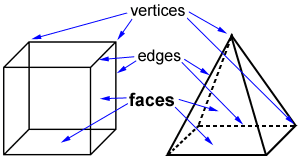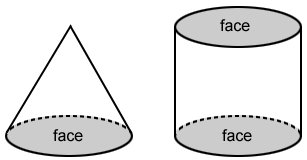Face
In geometry, a face is a planar (flat) surface of a 3D geometric figure. The figure below shows faces for two geometric figures, a cone, and a prism. Not all space figures have faces. For instance, a pyramid has faces but a sphere does not.

A face is a surface that is commonly seen in everyday life. We sleep on the face of a bed, sit on the face of a chair, and work on the face of a desk.
Faces of a polyhedron
If a closed space object is formed entirely by polygons, it is a polyhedron. The word polyhedron originates from a Greek word, where the term "poly" means many, and "hedron" means base or seat.

Polyhedrons are made up of faces, edges, and vertices. The edges of a polyhedron are line segments that are the intersection of two faces. The vertices are points where three or more edges meet. Euler's Theorem shows a relationship between the faces, vertices, and edges of a polyhedron. It states that the sum of the faces and vertices, minus the number of edges, always equals two:
F + V - E = 2
where F = number of faces, V = number of vertices, and E = number of edges.
Faces of non-polyhedra
The faces of a 3D figure are not always polygons. For example, the face of any circular cylinder or cone is a circle. The lateral sides are curved surfaces, so they are not considered faces.

